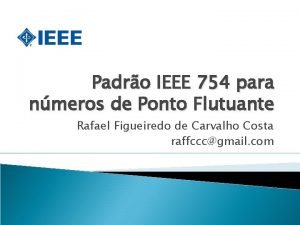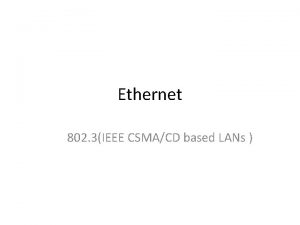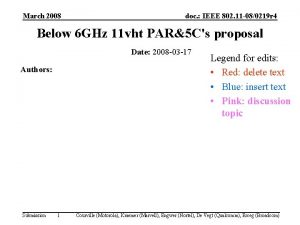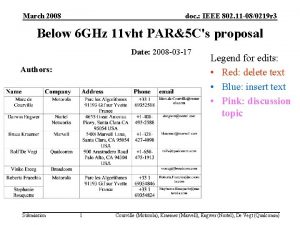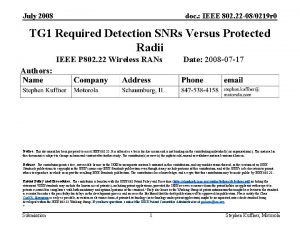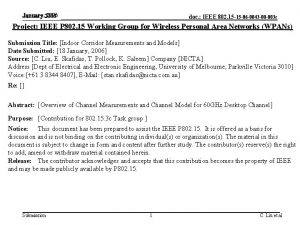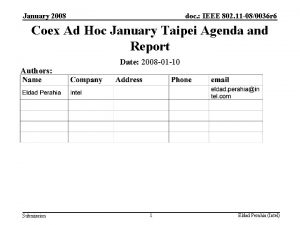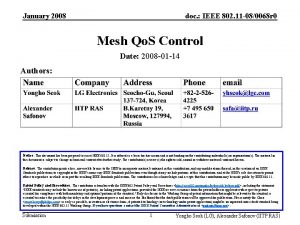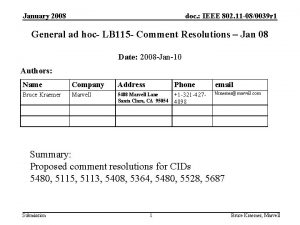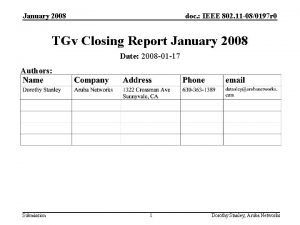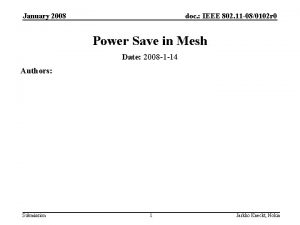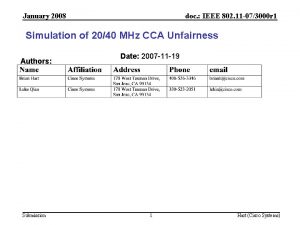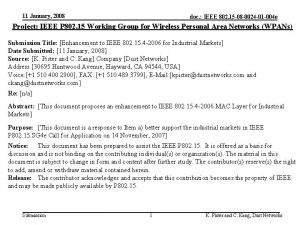January 2008 doc IEEE 802 11 080219 r













![January 2008 doc. : IEEE 802. 11 -08/0219 r 0 References • [1] Report January 2008 doc. : IEEE 802. 11 -08/0219 r 0 References • [1] Report](https://slidetodoc.com/presentation_image_h2/d2ddd255ababcce52ae948633569c2f1/image-14.jpg)
- Slides: 14

January 2008 doc. : IEEE 802. 11 -08/0219 r 0 Below 6 GHz 11 vht PAR&5 C's proposal Date: 2008 -02 -08 Authors: Submission 1 Courville (Motorola), Kraemer (Marvell), Engwer (Nortel), De Vegt (Qualcomm)

January 2008 doc. : IEEE 802. 11 -08/0219 r 0 Purpose of this document • This proposal is there to stimulate discussions and highlights a possible focus for below 6 GHz 11 VHT PAR and 5 C’s: please submit any constructive modifications. It exists in an open framework. • Recommendation: collectively we need to come up with – Refined analytical framework: metrics – Agreed upon terminology Submission 2 Courville (Motorola), Kraemer (Marvell), Engwer (Nortel), De Vegt (Qualcomm)

January 2008 doc. : IEEE 802. 11 -08/0219 r 0 Key elements emphasized in redaction • Concepts highlighted – Below 6 GHz unlicensed spectrum and possibility for licensed IMT. Adv operation, exclude 2. 4 GHz operation – Aggregate BSS throughput instead of single link throughput – WLAN Use Case Focused • Documents that served as a foundation for this proposal – – 02/798 r 7: HT SG draft PAR 02/799 r 6: HT draft 5 criteria 07/574 r 1: Draft PAR and 5 Criteria for the Gigabit Wireless Task Group 07/0081 r 2: Mobile cooperation usage models Submission 3 Courville (Motorola), Kraemer (Marvell), Engwer (Nortel), De Vegt (Qualcomm)

January 2008 doc. : IEEE 802. 11 -08/0219 r 0 Highlighted sections deserving specific attention PAR • Scope • Purpose • Need for the project 5 C’s 1. Broad Market Potential • • • 2. 3. Compatibility Distinct Identity • • • 4. 4 a) Demonstrated system feasibility. b) Proven technology, reasonable testing. c) Confidence in reliability Economic Feasibility • • • Submission a) Substantially different from other IEEE 802 standards b) One unique solution per problem (not two solutions to a problem) c) Easy for the document reader to select the relevant specification Technical Feasibility • • • 5. a) Broad sets of applicability b) Multiple vendors and numerous users c) Balanced costs (LAN versus attached stations) a) Known cost factors, reliable data b) Reasonable cost for performance c) Consideration of installation costs Courville (Motorola), Kraemer (Marvell), Engwer (Nortel), De Vegt (Qualcomm)

January 2008 doc. : IEEE 802. 11 -08/0219 r 0 PAR: scope (evolution of 08/121 r 0) • The scope of this project is to define an amendment that shall define standardized modifications to both the 802. 11 physical layers (PHY) and the 802. 11 Medium Access Control Layer (MAC) so that modes of operation can be enabled that are capable of supporting: – A multi-user BSS peak aggregated throughput of at least 1 Gbps as measured at the MAC data service access point (SAP) – Robust and flexible bandwidth management: native support for simultaneous multiple bandwidth operation (within a given frequency band) – Add optional outdoor compatible delay spread resistance – Below 6 GHz carrier frequency operation excluding 2. 4 GHz operation and ensuring backward compatibility with legacy IEEE 802. 11 a/n devices in the 5 GHz unlicensed band. Submission 5 Courville (Motorola), Kraemer (Marvell), Engwer (Nortel), De Vegt (Qualcomm)

January 2008 doc. : IEEE 802. 11 -08/0219 r 0 PAR: purpose (evolution TGn) • The purpose of the project is to improve the 802. 11 wireless local area network (LAN) user experience by providing significantly higher aggregated throughput for existing WLAN application areas and to enable new applications and market segments such as the ones defined by the ITU covering the nomadic mobility scenarios of the IMT-Advanced systems [1]. Submission 6 Courville (Motorola), Kraemer (Marvell), Engwer (Nortel), De Vegt (Qualcomm)

January 2008 doc. : IEEE 802. 11 -08/0219 r 0 PAR: need for the project (07/574 r 1) • As wireless networks are deployed, users are able to transition applications from fixed, non-wireless links to the convenience, freedom and versatility of wireless links. These transitions create an evolutionary demand to enhance the wireless network to support new classes of applications with higher bandwidth requirements. Wireless networks are particularly in need of continual enhancements since the link is by definition shared. • This project will meet that evolving need for higher bandwidth in the projected completion timeframe and enable the transition of the next class of applications to nomadic wireless local area network (LAN) links. Submission 7 Courville (Motorola), Kraemer (Marvell), Engwer (Nortel), De Vegt (Qualcomm)

January 2008 doc. : IEEE 802. 11 -08/0219 r 0 Broad Market Potential (evolution of 07/574 r 1) a) Broad sets of applicability – – – According to In. Stat and ABI Research, demand for WLAN is expected to grow at a 34% Compound Annual Growth Rate (CAGR) over the next five years. Over 75% of all homenetworking connections and over 95% of all mobile PC network connections will be via WLAN links by 2011. More than 12% of mobile phones are expected to include Wi-Fi connectivity by 2011. New uses such as multimedia, simultaneous transmission of multiple HDTV signals, audio, and on-line gaming, immersive environments and cooperative transmissions, will drive the need for higher throughput both in the home and for nomadic mobility outdoor environments. As usage increases in the outdoor, corporate and other high-density environments (e. g. a 20% increase in number of hotspots is expected between 2008 and 2011), bandwidth restrictions of a shared media will start to occur. This is very similar to what happened in the wired Ethernet market where the need for higher throughput drove the development and adoption of Fast Ethernet (100 Mbps). The need for higher throughput drove switching and 100 Base-TX adoption, then Gigabit Ethernet (Gb. E), then 10 Gb. E. While a switching technology would be desirable for WLAN, this is not technically feasible. 802. 11 developments have followed a similar progression from 1 & 2 Mbps, to 11 Mbps, to 54 Mbps, to 300 and 600 Mbps. The next logical step in wireless LAN technology is to further increase the data throughput of each WLAN link. In parallel to the traditional legacy usage for WLAN, with the framework of the IMT. Advanced certification process the ITU has opened up the possibility for nomadic 1 Gbps WLAN technology to access the IMT. Advanced licensed spectrum identified by WRC’ 07, providing a means for broadening even further the applicability of WLAN technologies. Submission 8 Courville (Motorola), Kraemer (Marvell), Engwer (Nortel), De Vegt (Qualcomm)

January 2008 doc. : IEEE 802. 11 -08/0219 r 0 Broad Market Potential (evolution of 07/574 r 1) b) Multiple vendors and numerous users. – c) A wide variety of vendors currently build numerous products for the WLAN marketplace. According to ABI Research Wireless LAN revenues is expected to surpass $6 B by 2011 and it is anticipated that the majority of those vendors, and others, will participate in the standards development process and subsequent commercialization activities. Balanced costs (LAN versus attached stations). – WLAN equipment is accepted as having balanced costs. The development of Gigabit Wireless capabilities will not disrupt the established balance Submission 9 Courville (Motorola), Kraemer (Marvell), Engwer (Nortel), De Vegt (Qualcomm)

January 2008 doc. : IEEE 802. 11 -08/0219 r 0 Compatibility (evolution 07/574 r 1) • Compatibility with IEEE 802 requirements will be accomplished by keeping the MAC SAP interface the same as the existing 802. 11 standard. – The proposed amendment shall introduce no 802. 1 architectural changes. – The MAC SAP definition shall not be altered, ensuring that all LLC and MAC interfaces are compatible to and in conformance with the IEEE 802. 1 Architecture, Management and Internetworking standards. – New managed objects shall be defined as necessary in a format and structure consistent with existing 802. 11 managed objects. • Backward compatibility with legacy devices will be granted for the 5 GHz bands. • The possibility of operating in a VHT greenfield mode will be allowed. – This greenfield mode would not require the overhead of backward compatibility mechanisms and thus be more efficient in terms of aggregated MAC SAP throughput. Submission 10 Courville (Motorola), Kraemer (Marvell), Engwer (Nortel), De Vegt (Qualcomm)

January 2008 doc. : IEEE 802. 11 -08/0219 r 0 Distinct Identity (07/574 r 1) a) Substantially different from other IEEE 802 standards. – – – b) This project will result in a wireless LAN with higher aggregated throughput than that provided by 802. 11 a, 802. 11 b, 802. 11 g and 802. 11 n. The goal is to increase the overall system throughput by considering new technologies, for the both PHY and MAC layers, operating below the 6 GHz band. VHT will allow a corporate or home user to roam from high-throughput, dense cells to wider area networks in a seamless manner while maintaining full support for the installed base security, management, diagnostics and backbone infrastructure. This will be supported by maintaining backwards compatibility to 802. 11 standards like for instance 802. 11 i/w for security, 802. 11 s for mesh networking, 802. 11 k/v for network management. The VHT amendment will also consider the possibility to access to the IMT-Advanced licensed spectrum. IEEE P 802. 15 TG 3 c intends to support higher physical data rates than those currently defined by P 802. 15 task group 3, and similar to those targeted by this proposal. However, the applications of 802. 11 and 802. 15 are different. 802. 15 defines standards for short-range wireless personal area networks, 802. 11 defines standards for relatively longer-range wireless local area networks. The different requirements of each group will result in different standards that satisfy the purpose and scope defined in each project’s PAR. One unique solution per problem (not two solutions to a problem). – c) There are no other wireless LAN standards providing significantly higher aggregated throughput than 802. 11 vht. Easy for the document reader to select the relevant specification. – The 802. 11 vht amendment will differentiate itself from other IEEE 802 wireless standards via the title which stresses the specification of gigabit speed WLAN technology. Submission 11 Courville (Motorola), Kraemer (Marvell), Engwer (Nortel), De Vegt (Qualcomm)

January 2008 doc. : IEEE 802. 11 -08/0219 r 0 Technical Feasibility (07/574 r 1) a) Demonstrated system feasibility. – – – b) Proven technology, reasonable testing. – c) The following documents are examples that support the feasibility of elements of gigabit wireless technology: [Gb. Testbed]: Gigabit MIMO OFDM Testbed (Siemens) [PIMRC’ 06]: 8 x 8 MU-MIMO Testbed (NTT) As a further illustration of feasibility, Draft 802. 11 n equipment is already in use, which demonstrates the ability of current devices to deliver link-rates of 300 Mbps. The 802. 11 n specification includes optional features that allow the support of link rates up to 600 Mbps. A simple example to demonstrate the feasibility of achieving link rates in excess of 1 Gbps would be to double the channel width, which would yield a linkrate of 1. 2 Gbps. MAC and PHY enhancements and additional MIMO dimensions can be brought to bear on the project which will yield throughputs of over 1 Gbps. Until the full extent of the user models referenced in the IEE 802. 11 vht PAR is understood, the study group cannot completely assess the extent of reasonable testing for those technologies. However, 802. 11 is a mature technology which has a wide variety of legacy devices and a proven track record, with hundreds of millions of devices shipping each year and the increased capabilities envisioned for the baseband RF parts necessary to implement the proposed amendment are in line with the current progress in semiconductor technology. Confidence in reliability – Analysis of current WLAN products and new academic research provides confidence in the reliability of the technology that will be developed by the project. There are currently reliable WLAN solutions. The study group envisions that the project will result in similar or improved reliability over current levels. Submission 12 Courville (Motorola), Kraemer (Marvell), Engwer (Nortel), De Vegt (Qualcomm)

January 2008 doc. : IEEE 802. 11 -08/0219 r 0 Economic Feasibility (07/574 r 1) a) Known cost factors, reliable data. – Support of the proposed standard will likely require a manufacturer to develop a modified radio, modem and firmware. This is similar in principle to the transition between 802. 11 b or 802. 11 g and 802. 11 n, or between 802. 11 a and 802. 11 n. The cost factors for these transitions are well known and the data for this is well understood. b) Reasonable cost for performance. – The new standard will provide manufacturers the ability to support aggregated gigabit per second wireless throughput speeds. In general, the cost factor changes needed to implement the technology envisioned by the study group are well within the capabilities of existing technology. Competition between manufacturers will ensure that costs remain reasonable. c) Consideration of installation costs. – The proposed amendment has no known impact on installation costs. Submission 13 Courville (Motorola), Kraemer (Marvell), Engwer (Nortel), De Vegt (Qualcomm)
![January 2008 doc IEEE 802 11 080219 r 0 References 1 Report January 2008 doc. : IEEE 802. 11 -08/0219 r 0 References • [1] Report](https://slidetodoc.com/presentation_image_h2/d2ddd255ababcce52ae948633569c2f1/image-14.jpg)
January 2008 doc. : IEEE 802. 11 -08/0219 r 0 References • [1] Report ITU-R M. 1645 “Framework and overall objectives of the future development of IMT‑ 2000 and systems beyond IMT‑ 2000” http: //www. ieee 802. org/18/Meeting_documents/2007_Jan/R-REC-M. 1645 -0200306 -I!!MSW-E. doc • 08/0172 r 0: IMT-Advanced Opening Report • 02/798 r 7: HT SG draft PAR • 02/799 r 6: HT draft 5 criteria • 07/574 r 1: Draft PAR and 5 Criteria for the Gigabit Wireless Task Group • 08/121 r 0: Mobile cooperation usage models • 07/2988 r 0: Liaison from Wi-Fi Alliance to 802. 11 regarding WFA VHT Study Group Consolidation of Usage Models • 07/0081 r 2: Mobile cooperation usage models • 11 -07 -2187 -00 -0 vht-another-resource-to-exploit-multi-user-diversity. ppt • [Gb. Testbed]: http: //iaf-bs. de/projects/gigabit-mimo-ofdm-testbed. en. html • [PIMRC’ 06]: Performance Evaluation of 8 x 8 Multi-User MIMO-OFDM Testbed in an Actual Indoor Environment, IEEE PIMRC’ 06 Submission 14 Courville (Motorola), Kraemer (Marvell), Engwer (Nortel), De Vegt (Qualcomm)













